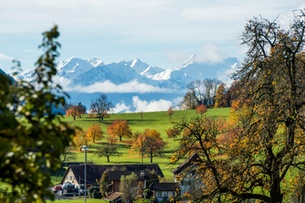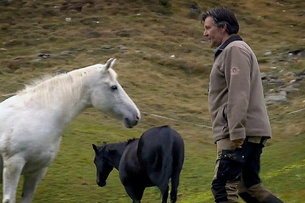The numbers of farms in Switzerland has halved since 1980 - Click to enlarge The trend for fewer but larger farms continued in Switzerland last year, with the total number dropping by 990 to 52,263. While small and conventionally farmed businesses were throwing in the towel, organic agriculture flourished. The number of jobs in farming dropped 1.3% to 153,400, of which two-thirds were full-time, the Federal Statistical Officeexternal link said on Thursday. It added that 55,600 women were employed in Swiss agriculture, with almost 3,000 being managers. As in previous years, the number of farms with an area of more than 30 hectares rose, last year by 1.9%, while the number of very small operations continued to shrink, by 2.9%. With 2015 seeing a decrease in earnings, smaller producers are also feeling the consequences of an agricultural policy that they say favours … Reasons for this include the consequences of an agricultural subsidy policy that smaller farmers say favours larger and more efficient farms. The organic boom continued, however. Last year there were 6,348 organic farms, 104 more than the previous year. Of those 104, 27% specialised in milk production and 12% in meat production. The total utilised agricultural area came to an unchanged 1.05 million hectares. Of this, 14% was organic.
Topics:
Swissinfo.ch considers the following as important: Business, Featured, newslettersent, Swiss Markets and News
This could be interesting, too:
RIA Team writes The Importance of Emergency Funds in Retirement Planning
Nachrichten Ticker - www.finanzen.ch writes Gesetzesvorschlag in Arizona: Wird Bitcoin bald zur Staatsreserve?
Nachrichten Ticker - www.finanzen.ch writes So bewegen sich Bitcoin & Co. heute
Nachrichten Ticker - www.finanzen.ch writes Aktueller Marktbericht zu Bitcoin & Co.
The trend for fewer but larger farms continued in Switzerland last year, with the total number dropping by 990 to 52,263. While small and conventionally farmed businesses were throwing in the towel, organic agriculture flourished.
The number of jobs in farming dropped 1.3% to 153,400, of which two-thirds were full-time, the Federal Statistical Officeexternal link said on Thursday. It added that 55,600 women were employed in Swiss agriculture, with almost 3,000 being managers.
As in previous years, the number of farms with an area of more than 30 hectares rose, last year by 1.9%, while the number of very small operations continued to shrink, by 2.9%.
Reasons for this include the consequences of an agricultural subsidy policy that smaller farmers say favours larger and more efficient farms.
The organic boom continued, however. Last year there were 6,348 organic farms, 104 more than the previous year. Of those 104, 27% specialised in milk production and 12% in meat production.
The total utilised agricultural area came to an unchanged 1.05 million hectares. Of this, 14% was organic. Meadows made up most of the total (58%), with 38% devoted to crops (mostly wheat). The remaining 4% was divided between vineyards and orchards at 13,400 hectares and 7,200 hectares respectively.
Global trend
The long-term trend in Switzerland towards fewer farms is reflected in almost all Western countries.
The United States Department of Agriculture said in a February 2017 reportexternal link that “the number of farms in the United States for 2016 is estimated at 2.06 million, down 8,000 farms from 2015. Total land in farms, at 911 million acres [369 million hectares], decreased 1 million acres from 2015”.
Switzerland’s neighbours also saw the number of farms fall continuously between 2005 and 2013.
Figures from Eurostatexternal link, the European Union’s statistics body, looked at “agricultural holdings”, which it defined as “a single unit both technically and economically, which has single management and which produces agricultural products”.
In Germany, they fell from 390,000 in 2005 to 285,000 in 2013. Over the same period, farms in France dropped from 567,000 to 472,000, in Italy from 1.73 million to 1.01 million and in Austria from 170,000 to 140,000.
Tags: Business,Featured,newslettersent


